

Corine Renel
Introduction. 1.

Students learn isolated skills and knowledge, starting with the simple building blocks of a particular topic and then building to more complex ideas. While this appeals to common sense (think of the efficiency of a automobile assembly line), the problem with this approach is the removal of any context to the learning, making deep understanding of the content less likely.
Perkins calls this approach elementitis, where learning is structured exclusively around disconnected skills and fragmented pieces of information. 2. Students learn about a particular topic. The solution that Perkins offers to the typical classroom experience is what he calls learning by wholes, structuring learning around opportunities to experience or engage in the topic as it would exist outside of school. An example of ‘learning by wholes’ can be found in my own Cigar Box Project, a year-long, grade 7 study where students explored 5 themes in Canadian history. Inquiry as “Play” Teaching inquiry learning. What Makes Project Based Learning Effective? #Edchat #EngChat. I've been meaning to write about my adventures in Project Based Learning for a while.
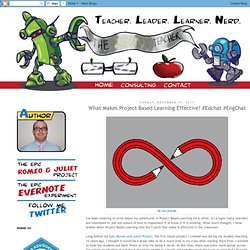
It's a topic many teachers are interested in, but are unsure of how to implement it or know if it is working. After much thought, I have broken down Project Based Learning into the 5 parts that make it effective in the classroom. Long before my Epic Romeo and Juliet Project, the first major project I created was during my student teaching 10 years ago. I thought it would be a great idea to do a mock trial in my class after reading Huck Finn.
I wanted to have the students put Mark Twain on trial for being a racist. Problem based learning. Inquiry Based Learning. TWT: Inquiry-based Learning Strategy. What is Inquiry-based learning?
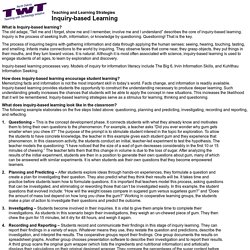
The old adage, “Tell me and I forget, show me and I remember, involve me and I understand” describes the core of inquiry-based learning. Inquiry is the process of seeking truth, information, or knowledge by questioning. Questioning! That is the key. The process of inquiring begins with gathering information and data through applying the human senses: seeing, hearing, touching, tasting, and smelling. Design-Based Learning (DBL) to Innovate STEM Education. Our earthquake curriculum project We developed an earthquake curriculum to conduct design-based pilot studies all over the globe from Ethiopia to California in 5th, 6th grade classes and a multi-grade classroom in El Salvador.
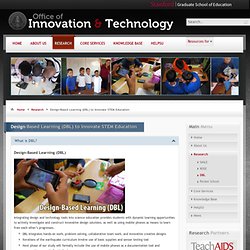
Learning about earthquakes is urgent and propitious with the recent earthquake catastrophes in Haiti and Chile. It is crucial to raise awareness in our young learners that an earthquake in one continent can have ripple effect damages to other continents. In the future, we expect our future leaders to collaborate to understand the natural phenomena and embrace ourselves to prepare and respond together. Within the design challenge, students worked in teams of 4 members to design and build earthquake resistant structures using only index cards, tape, and paper clips through couple of iterations.
Throughout our pilot studies, students were enthusiastic, focused, and actively collaborating with their peers. Sub Project. Inquiry-based Learning: Explanation. What are the benefits of inquiry-based learning?
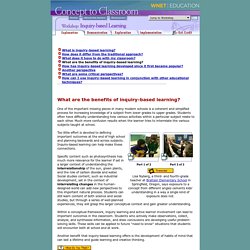
One of the important missing pieces in many modern schools is a coherent and simplified process for increasing knowledge of a subject from lower grades to upper grades. Students often have difficulty understanding how various activities within a particular subject relate to each other. Much more confusion results when the learner tries to interrelate the various subjects taught at school. Difference betweeen Inquiry Learning and Taditional Approach. How does it differ from the traditional approach?
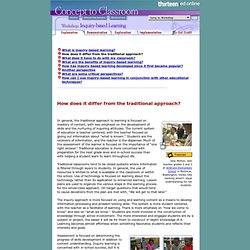
In general, the traditional approach to learning is focused on mastery of content, with less emphasis on the development of skills and the nurturing of inquiring attitudes. The current system of education is teacher centered, with the teacher focused on giving out information about "what is known. " Students are the receivers of information, and the teacher is the dispenser. Much of the assessment of the learner is focused on the importance of "one right answer. " Traditional education is more concerned with preparation for the next grade level and in-school success than with helping a student learn to learn throughout life. Traditional classrooms tend to be closed systems where information is filtered through layers to students.
Search Results: physics. How to: Inquiry. Will you ever just walk into class and ask, "Okay, what do you want to study today?

" Of course not. Inquiry-based learning is founded on students taking the lead in their own learning, but it still requires considerable planning on your part. Projects must fit into your larger program structure, goals and plans, but the students will be actively involved in planning the projects with you and asking the questions that launch their individual inquiries. The Importance of Planning It's impossible to project all the possible ways in which you can build inquiry into programs, projects and activities, but preparing for most projects involves three basic steps: Pre-planning: Before going to the kids, determine any preliminary factors or characteristics that must be true in order to achieve your larger goals or plans. Ask questions such as "Where could you find resources to answer your questions?
" Step-by-Step Through the Techniques Step 1: Posing Real Questions Step 2: Finding Relevant Resources. Where Good Things Happen - Inquiry Learning - ICT Learning Experience. Fostering Inquiry-based Learning in Labs Using Google Spreadsheets. Instructors in lab courses often find it difficult to simulate and discuss all phases of scientific inquiry during a single class period.
For instance, individual lab groups may not be able to replicate experimental trials sufficiently in the time allotted, requiring instructors to compile data sets across lab groups before students can properly analyze and interpret results.Google Spreadsheets can circumvent this logistical barrier by allowing instructors to crowdsource the data aggregation and “cleaning” during class.
For example, Chad Hershock and Rachel Niemer, CRLT, teach a short-course for postdocs on college teaching in science and engineering. During a unit on converting traditional, “cookbook” lab exercises into inquiry-based activities, postdocs work in pairs to complete a sample lab protocol. All the pairs then enter their data into a single Google Spreadsheet, so that the class compiles a robust class data set in real time, without any cutting and pasting across files.
I-Le@rn: Lifelong Learning Cluster of the University of Mauritius. Vrutah. Shibanitoocaram.